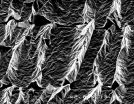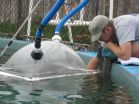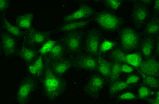(Press-News.org) We know of about two dozen runaway stars, and have even found one runaway star cluster escaping its galaxy forever. Now, astronomers have spotted 11 runaway galaxies that have been flung out of their homes to wander the void of intergalactic space.
"These galaxies are facing a lonely future, exiled from the galaxy clusters they used to live in," said astronomer Igor Chilingarian (Harvard-Smithsonian Center for Astrophysics/Moscow State University). Chilingarian is the lead author of the study, which is appearing in the journal Science.
An object is a runaway if it's moving faster than escape velocity, which means it will depart its home never to return. In the case of a runaway star, that speed is more than a million miles per hour (500 km/s). A runaway galaxy has to race even faster, traveling at up to 6 million miles per hour (3,000 km/s).
Chilingarian and his co-author, Ivan Zolotukhin (L'Institut de Recherche en Astrophysique et Planetologie/Moscow State University), initially set out to identify new members of a class of galaxies called compact ellipticals. These tiny blobs of stars are bigger than star clusters but smaller than a typical galaxy, spanning only a few hundred light-years. In comparison, the Milky Way is 100,000 light-years across. Compact ellipticals also weigh 1000 times less than a galaxy like our Milky Way.
Prior to this study, only about 30 compact elliptical galaxies were known, all of them residing in galaxy clusters. To locate new examples Chilingarian and Zolotukhin sorted through public archives of data from the Sloan Digital Sky Survey and the GALEX satellite.
Their search identified almost 200 previously unknown compact ellipticals. Of those, 11 were completely isolated and found far from any large galaxy or galaxy cluster.
"The first compact ellipticals were all found in clusters because that's where people were looking. We broadened our search, and found the unexpected," said Zolotukhin.
These isolated compact galaxies were unexpected because theorists thought they originated from larger galaxies that had been stripped of most of their stars through interactions with an even bigger galaxy. So, the compact galaxies should all be found near big galaxies.
Not only were the newfound compact ellipticals isolated, but also they were moving faster than their brethren in clusters.
"We asked ourselves, what else could explain them? The answer was a classic three-body interaction," stated Chilingarian.
A hypervelocity star can be created if a binary star system wanders close to the black hole at the center of our galaxy. One star gets captured while the other is thrown away at tremendous speed.
Similarly, a compact elliptical could be paired with the big galaxy that stripped it of its stars. Then a third galaxy blunders into the dance and flings the compact elliptical away. As punishment, the intruder gets accreted by the remaining big galaxy.
This discovery represents a prominent success of the Virtual Observatory - a project to make data from large astronomical surveys easily available to researchers. So-called data mining can result in finds never anticipated when the original data was collected.
"We recognized we could use the power of the archives to potentially unearth something interesting, and we did," added Chilingarian.
INFORMATION:
You think that your immune system is there to protect you. But what happens when it starts working against you?
In the earliest stages of cancer formation, the immune system is forced to make a momentous decision. It either activates and suppresses tumor growth to help the body fight disease, or it becomes dysfunctional, helping the tumor grow and making treatment more difficult. Because this tipping point occurs before a person even realizes something is wrong, doctors are unable to directly observe this critical stage.
"We believe that when immune cells enter a tumor ...
WORCESTER, MA - Scientists at the University of Massachusetts Medical School have applied a powerful tool in a new way to characterize genetic variants associated with human disease. The work, published today in Cell, will allow scientists to more easily and efficiently describe genomic variations underlying complex, multi-gene diseases.
"Up to this point, we've only been able to investigate one disease-causing mutation at a time," said principal investigator Marian Walhout, PhD, co-director of the Program in Systems Biology and professor of molecular medicine at UMMS. ...
The oncologists Manuel Hidalgo, Director of the Clinical Research Programme of the Spanish National Cancer Research Centre (CNIO), and Ignacio Garrido-Laguna, member of the Experimental Therapeutics Program at Huntsman Cancer Institute of the University of Utah (USA), have recently published a review of state-of-the-art clinical treatments for pancreatic cancer -- including the most current therapies and innovative research -- in the prestigious scientific journal Nature Reviews Clinical Oncology.
In their study, which reviews around 200 scientific articles published ...
PROVIDENCE, R.I. [Brown University] -- Using a technique that introduces tiny wrinkles into sheets of graphene, researchers from Brown University have developed new textured surfaces for culturing cells in the lab that better mimic the complex surroundings in which cells grow in the body.
"We know that cells are shaped by their surroundings," said Ian Y. Wong, assistant professor of engineering and one of the study's authors. "We've shown that you can make textured environments for cell culture fairly easily using graphene."
Traditionally, cell culture in the lab has ...
An enzyme secreted by the body's fat tissue controls energy levels in the brain, according to new research at Washington University School of Medicine in St. Louis. The findings, in mice, underscore a role for the body's fat tissue in controlling the brain's response to food scarcity, and suggest there is an optimal amount of body fat for maximizing health and longevity.
The study appears April 23 in the journal Cell Metabolism.
"We showed that fat tissue controls brain function in a really interesting way," said senior author Shin-ichiro Imai, MD, PhD, professor of ...
Dolphins that raise their voices to be heard in noisy environments expend extra energy in doing so, according to new research that for the first time measures the biological costs to marine mammals of trying to communicate over the sounds of ship traffic or other sources.
While dolphins expend only slightly more energy on louder whistles or other vocalizations, the metabolic cost may add up over time when the animals must compensate for chronic background noise, according to the research by scientists at NOAA Fisheries' Northwest Fisheries Science Center and the University ...
TORONTO, ON. (23 April, 2015) - A new study led by University of Toronto researcher Dr. David Lam has discovered the trigger behind the most severe forms of cancer pain. Released in top journal Pain this month, the study points to TMPRSS2 as the culprit: a gene that is also responsible for some of the most aggressive forms of androgen-fuelled cancers.
Head of Oral and Maxillofacial Surgery at the Faculty of Dentistry, Lam's research initially focused on cancers of the head and neck, which affect more than 550,000 people worldwide each year. Studies have shown that these ...
ROCHESTER, Minn. -- A 47-year-old African-American woman has heavy menstrual bleeding and iron-deficiency anemia. She reports the frequent need to urinate during the night and throughout the day. A colonoscopy is negative and an ultrasonography shows a modestly enlarged uterus with three uterine fibroids, noncancerous growths of the uterus. She is not planning to become pregnant. What are her options?
Elizabeth (Ebbie) Stewart, M.D., chair of Reproductive Endocrinology at Mayo Clinic, says the woman has several options, but determining her best option is guided by her ...
ANN ARBOR--Use of clean fuels and updated pollution control measures in the school buses 25 million children ride every day could result in 14 million fewer absences from school a year, based on a study by the University of Michigan and the University of Washington.
In research believed to be the first to measure the individual impact on children of the federal mandate to reduce diesel emissions, researchers found improved health and less absenteeism, especially among asthmatic children.
A change to ultra low sulfur diesel fuel reduced a marker for inflammation in ...
Boosting teenagers' ability to cope with online risks, rather than trying to stop them from using the Internet, may be a more practical and effective strategy for keeping them safe, according to a team of researchers.
In a study, more resilient teens were less likely to suffer negative effects even if they were frequently online, said Haiyan Jia, post-doctoral scholar in information sciences and technology.
"Internet exposure does not necessarily lead to negative effects, which means it's okay to go online, but the key seems to be learning how to cope with the stress ...



